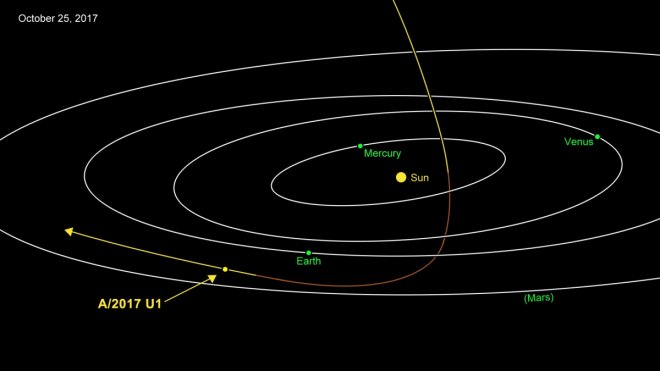
The International Astronomical Union (IAU) has classified the first "interstellar object" which entered our inner solar system as an asteroid and has named it "Oumuamua" or "a messenger from afar arriving first" in Hawaiian. They also predicted the existence of more interstellar objects which might be hazardous for the solar system, including the earth.
The IAU has also officially named the first interstellar asteroid as 1I/2017 U1. It used the letter "I" to represent "interstellar" just as "C" and "A" was used as a symbol for comets and asteroids.
The IAU website stated, "Considering the growing interest in the observations and orbit determination of asteroids (see the International Asteroid Warning Network (IAWN) initiative http://iawn.net/), it is expected that the discovery of 1I/2017 U1 (Oumuamua) will soon be joined by discoveries of more of such interlopers entering the inner Solar System from Interstellar space."
It said the scheme for their designation is ready, while the procedure for assigning them a name, similar to the one in use for minor planets, will soon be decided.
Oumuamua or 1I/2017 U1 was discovered on Oct. 19 using the Panoramic Survey Telescope and Rapid Response System 1 (Pan-STARRS 1) telescope of the University of Hawaii. The researchers, who were searching for near-Earth objects for NASA, have found the high-speed object which was less than a quarter-mile (400 meters) in diameter.
Astronomers from around the world have worked on the data collected from different telescopes to clarify that the interstellar object was indeed an asteroid.
According to a NASA report, Rob Weryk, a postdoctoral researcher at the University of Hawaii Institute for Astronomy (IfA), was the first person to observe Oumuamua. He submitted his observation analysis to the Minor Planet Center and searched the image archives from the Pan-STARRS. The images captured by the Pan-STARRS from the previous night also had the flying object.
Rob Weryk said, "Its motion could not be explained using either a normal solar system asteroid or comet orbit." Rob Weryk contacted Marco Micheli, an IfA graduate who had similar observations. Marco Micheli had made his observations using the European Space Agency's telescope on Tenerife in the Canary Islands. Weryk said, "This object came from outside our solar system."
According to the graph plotted by the CNEOS from the objects current trajectory, 1I/2017 U1 came from the direction of the constellation Lyra and traveled through the interstellar space at a speed of 15.8 miles (25.5 Km) per second. It approached our solar system from an angle perpendicular to the ecliptic, the plane where the planets and the asteroids orbit our sun.
Oumuamua crossed the ecliptic plane just inside of the Mercury's orbit on Sept. 2. It then made its closest approach to the sun on Sept. 9. It had made a hairpin turn under our solar system due to the Sun's gravity. It also passed under Earth orbit on Oct. 14 at a distance of about 15 million miles (24 million Km), at a distance which is 60 times the distance between Earth and Moon. The interstellar asteroid has moved out of ecliptic plane and is currently moving towards the Constellation Pegasus at a speed of 27 miles (44 Km) per second.
Conspiracy theorists have been giving warnings about the doomsday of earth and with the IAU giving such hints of interstellar objects posing threat to the earth, the clamor for a safe future is getting more attention.
According to them, a mysterious planet named as Nibiru or PlanetX would hit the earth resulting in its destruction. The conspiracy theorists also blame the Nibiru for the recent earthquakes, hurricanes and other natural calamities on earth.
Several predicted doomsdays have passed off without any event and now their new date with destiny is Nov. 19.









